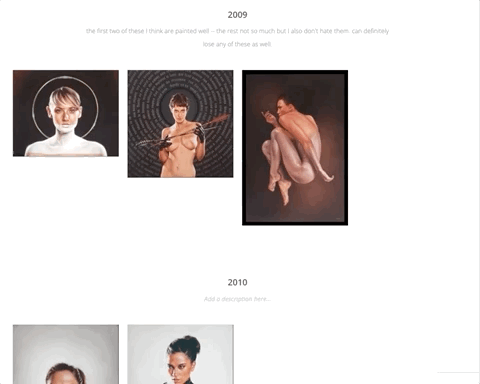BOOK THOUGHTS PT.II
What goes in it?
One of the most challenging parts of putting the book together was deciding which work to include. I didn’t actually realize the book would contain work from an even 10 years until we were months in. But that turned out to be a good starting point. Everything I did before 2008 was definitely not good enough to include, and it allowed me to stop waiting to include the next new painting. (Much like beginning to show work in the first place, I’m never “ready” — but I do have confidence I’ll paint the next one better. Good for progress, but also bad for progress). Thankfully I have learned that there is always a next one, so waiting for that entirely fictional moment of artistic contentment is not a good idea. 10 years it is.
The obvious first step was to compile everything into one spot. This took forever. I am generally pretty organized, but keeping track of 150ish paintings — all of the various files, edits, and color-corrections over a decade — plus throw in all the chaos caused by a few different computers and over 10 hard drives. and as a bonus, there are a few years of nothing right in the middle there too — thank you the Purge.
A note to fellow artists out there, I can’t stress enough how important it is to get good high quality images of your art, even the stuff you hate. there may come a time where the digital record is all that’s left of a particular piece (practically speaking), and you will forget it ever even existed. And you may need it — nobody wants to go find pieces and have them re-shot.
After an initial scrub of paintings I absolutely hated, and files that just weren’t good enough to print, the easiest method of curation turned out to be an online prototyping site I use for my website clients. All the images in one long page — essentially a giant modular contact sheet. At this point it’s important to mention that I had enlisted the help of Ryan Malley and Jenny Ji. Ryan has a bunch of experience with book projects, including working with Jeremy Mann on his first book. Jenny is a book designer who knows all the technical stuff unique to book design that I had no clue about. They were both also a huge help in advising me on content, especially when it came to which paintings to include. My poor wife, who deals with a lot chronic indecisiveness from me, often was the push I needed to include or remove a particular piece. I am entirely aware that I am not a good judge of the quality of my own work, especially the subjective quality (ie what makes people like the painting). I can’t imagine that any artist is very good at that.
just some of the paintings in “purgatory”, most of which did not make it in.
We ended up with around 60 paintings for the book, removing ones we thought weren’t as strong, or weren’t necessary for one reason or another. It was always important to me to have a lot of ancillary content in the book; studio shots, in-progress progress shots, etc. That’s often the stuff I find most interesting in the art books I have. It can provide more of a sense of the artist and their work than the work alone can — or maybe I just like finding out the artists I like are total slobs. or more often…crazy people.

